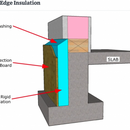Terminating Exterior Insulation
I keep going back and forth with my foundation contractor regarding insulation. I have been planning to install 2″, R10 insulation board from the footings to above grade where the insulation meets the bottom of the exterior wall (see photo). This, based on what I’ve read, is the best way to prevent heat from escaping/bridging between the bottom of the sill plate and top of the foundation wall.
My foundation contractor insists I’m overthinking it and that the insulation does not need to extend above grade, but instead can be cut-off where the insulation comes up to the top of the slab.
I don’t know what’s right, but I most certainly want to make my investment in the insulation achieve the best results possible.
GBA Detail Library
A collection of one thousand construction details organized by climate and house part










Replies
Scott,
Your contractors advice is a bit contradictory. Above Grade is not the same as the Top of the Slab.
Whether you extend it over the bottom plate or not, you certainly need to make sure all the exterior concrete is covered or you will get a big thermal bypass.
One benefit of terminating it at the top of the foundation and not covering the bottom plate is a cleaner detail at exterior doors.
You don't need to cant the top of the foam, just slope the cap flashing 10 degrees.
Malcom,
Thanks and good point about the contradiction. I reread his message and he actually said cut it off at the bottom of the slab, but that would still be above grade. At any rate, by doing what my foundation contractor suggests, there would be about 12 inches of exposed exterior concrete. The slab will be 4 inches and there's 8 inches between the top of slab and the top of the foundation wall/bottom of plate. Finished grade will be roughly at bottom of slab.
Thanks for the confirmation about preventing the thermal bypass.
As Malcolm mentioned, you need that insulation to extend up past all the otherwise UNinsulated parts of the assembly. Your drawing has the right idea. If you use exterior rigid foam of the same thickness as the material you use on the foundaiton wall, you can effectively continue the continous insulation all the way up to the underside of the soffit, which is pretty much idea. If you were to do this, I'd use XPS below grade and transition to polyiso when you get up to the wood framing. A beveled cut as you show in your drawing is a good idea to avoid any chance of pooling water.
Bill